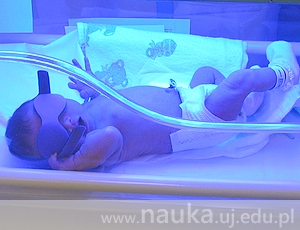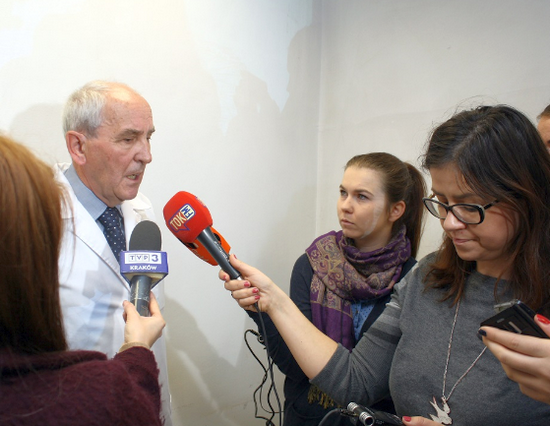
The latest discovery made by Children’s University Hospital in Kraków medical staff may result in a more effective way of preventing complications in prematurely born babies.
The researchers have examined 119 preemies, searching for genetic causes of chronic lung disease and retinopathy of prematurity. As it turns out, the organisms of these children produced different sets of proteins based on their maturity.
Kraków, Warsaw, Oslo
‘Aside from treating children, we’re performing various examinations to make sure our young patients receive the best medical assistance available. We’re also conducting world-class research in virtually all fields. Our hospital is a very complex machine’, said Dr hab. Maciej Kowalczyk, the hospital’s director.

One of these research projects is called Neomics. Prematurity epigenome and proteome as a clue for prediction of prematurity complications. It is conducted by a team from the Children’s Disease Clinic and Department of Medical Genetics of the JU MC Institute of Paediatrics. The scientists have already completed the first stage of their research. They set out to discover the indicators that will allow them to predict increased chance of genetic disorders, such as chronic lung disease or retinopathy of prematurity, which can lead to blindness. The project is simultaneously carried out in Kraków, Warsaw and Oslo.
The project is divided into two parts. The experimental part is handled by a research team led by Prof. Ola Saugstad from the University of Oslo. The second part, involving medical examinations in maternity wards in Kraków and Warsaw, is performed by two teams led by Prof. Jacek Pietrzyk and Prof. Maria Kornacka-Borszewska.
‘While working with children, we asked ourselves why preemies are often subject to medical complications which adversely affects their health in the future. We decided to conduct an in-depth study of this issue and investigate why some new-borns are more prone to disease than others despite being born in the same stage of development. We wanted to know why in some cases the symptoms are very severe, while in others they are very mild or non-existent’, explained Prof. Jacek Pietrzyk, head of the research project.
Genetic probes
 During the clinical part of the project, researchers have examined 119 new-borns born before the 30th week of pregnancy. The smallest of them weighed only 500 grams, the largest a little less than 1,400 grams. The test was designed to measure the organisms response to various factors, like oxygen level, infection and medicine, during all stages of the babies’ development. The researchers analysed their gene expression, the protein concentration in their blood, and took samples of their thrombocytes to conduct experiments. For instance, they used special devices to create cell cultures and observed their reaction to different stimuli.
During the clinical part of the project, researchers have examined 119 new-borns born before the 30th week of pregnancy. The smallest of them weighed only 500 grams, the largest a little less than 1,400 grams. The test was designed to measure the organisms response to various factors, like oxygen level, infection and medicine, during all stages of the babies’ development. The researchers analysed their gene expression, the protein concentration in their blood, and took samples of their thrombocytes to conduct experiments. For instance, they used special devices to create cell cultures and observed their reaction to different stimuli.
The scientists employed the latest discoveries from the fields of molecular genetics and proteomics (a large-scale study of proteins). Only a few drops of blood were needed to perform the examination. ‘The preliminary results were very interesting. They’ve shown us the great complexity of processes which take place in a child’s organism. For instance, new-borns of varying maturity levels differed from one another when it came to protein production – in some cases up to 25%. Apart from being important from the scientific point of view, this knowledge also has practical applications’, stressed Prof. Jacek Pietrzyk.
To study the blood, the specialists from the Department of Molecular Genetics used DNA microarrays – glass platelets measuring about one square centimetre with several thousand to a few million probes attached to them. These probes are microscopic fragments of ‘model genes’ corresponding to several million unique fragments of real genetic material. A piece of real gene present in a blood sample may be attached to the probe, which causes the DNA microarray to emit light when touched by a laser ray.
‘DNA microarrays are so extraordinary because we can simultaneously study the entire genetic material. Every person's genetic material is composed of about three million genetic “letters”, grouped into twenty five thousand genes, and each of them can be additionally modified by recently discovered epigenetic mechanisms’, said Prof. Mirosław Bik-Multanowski, head of the JU MC Department of Medical Genetics. ‘We conduct our research using human genes and mice genes very similar to them. We’re looking for mechanisms responsible for serious medical complications in some of the preemies. If we learn which genes are responsible for lung disease and loss of sight in some new-borns, we’ll be better equipped to protect the children who are prone to disease, since we’ll be able to adjust our treatment’, he added.
The last stage of the project will involve preparing a synthesis of Norwegian and Polish clinical research. It will allow the scientists to confirm the difference of gene expression profiles and presence of certain proteins in the cells of the preemies who suffer from medical complications. In the long run, the researchers hope to establish if all preemies are genetically predisposed to such complications.
Original text: www.nauka.uj.edu.pl





